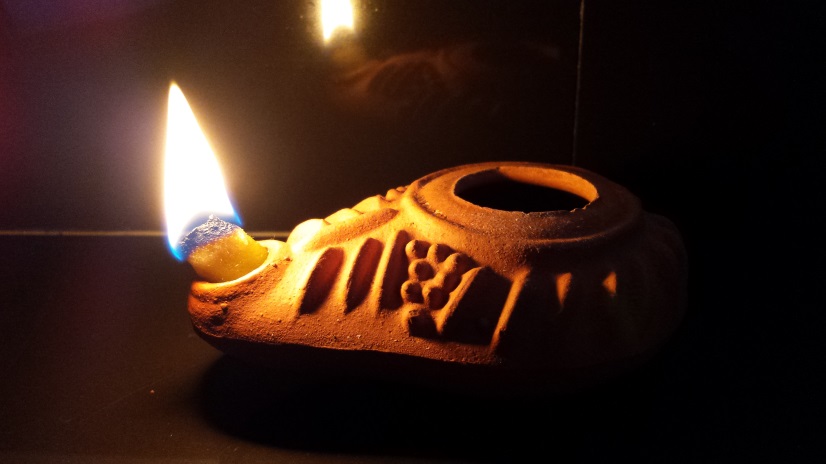The next stage in the cover design for The Flame Before Us is taking shape, in the form of the following clay lamp, using olive oil to produce its rather attractive flame. The final version will be much higher quality.

On the writing front, I have started now collating the first part into something approaching its final form… though there is a lot more work to do yet.
Also for today here are a few thoughts on A Journey in Other Worlds, by John Jacob Astor. This is a science fiction book published in 1894 and available these days in Kindle format, and describes a space journey taking place in the year 2000. I came across it through a Google+ post by a friend.
It is definitely of the old science fiction school in which the appeal of the book was reckoned to be in the lavish detail supplied of future inventions and society. I realised that EE “Doc” Smith (writing from around 1920 onwards) was following in the same pattern. They share the same tendency for male protagonists, supported by supremely beautiful and talented women who remain faithfully at home while their men go out and face danger. They also both posit a world where white American society (and to a lesser degree English culture) have dominated the world and other races and ethnicities have been absorbed or marginalised.
Astor, an extremely rich man who died on the Titanic, was himself something of an inventor, and clearly took great delight in long descriptions of the engineering feats of the future. One of the spaceship’s crew of three is on a well-earned rest after co-ordinating a global project to straighten the earth’s axis so that it is perpendicular to the orbital plane, in order to remove seasonal extremes. This feat is described in considerable length for those who want to put it into practice today – though in fact it would be as out of reach today as it was in Astor’s day.
Modern readers will probably be impatient with what comes over as great naivety about the role of science (an unmitigated boon and triumph of human ingenuity) and of politics (the right way to run the world is so abundantly obvious that there is no real opposition of any kind). And many modern readers, both religious and otherwise, will find difficulties with his methodology for fusing scientific and biblical statements. However, his ability to imaginatively project the knowledge of his time, and his recognition of the limits of knowledge, are both striking and appealing.
The book is divided into three parts: an initial review of life on planet earth, followed by extended descriptions of the explorers’ visits to Jupiter and Saturn. Jupiter is basically an extended big game hunt, together with musings on the ease with which parts of Jupiter could be appropriated for colonisation from earth. Not sharing the 19th century desire to hunt anything large enough to be shot at, I did not find this especially moving. The characters come over as unconsciously arrogant and parochial.
The Saturn trip, however, brings out a very different side to the crew. Anxieties and fears surface in them, along with existential fears that their lives are not, after all, up to the quality that they had imagined for themselves. As a result, this section of the book was much more engaging for me.
I found A Journey in Other Worlds to be an interesting book – significantly more modern in outlook than parts of Jules Verne, and with a clear line of descent through Smith to more recent writers. Not everybody will like the book, either for its writing style or the ideas expressed in it, but I am glad to have read it. It seems slightly churlish to rate a book of this kind, but for consistency with other books I would give four stars.
